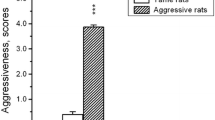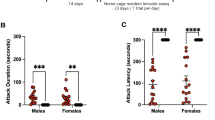Abstract
A variety of situations commonly used to assess aggression in laboratory rodents was studied in two outbred varieties and six inbred strains of mice. The situations investigated included attacks on anosmic TO-line standard opponents by males from individual housing, from pairings with females, or after exposure to electroshock. Lactating females were studied in similar tests. Locust killing (predatory aggression) and restraint-induced target biting were also studied in male subjects. Cohabitation with females was generally a less effective means of inducing social conflict that individual housing. Maternal aggression was absent in some lines but was characteristic of genotypes with the most aggressive males. Correlations performed between the different tests of aggression (based on a combined score reflecting incidenceand intensity data) confirmed earlier claims that locust killing and target biting are distinct from intraspecific forms of attack. These data caution against ready extrapolation between different tests.
Similar content being viewed by others
References
Brain, P. F. (1981). Differentiating types of attack and defense in rodents. In Brain, P. F., and Benton, D. (eds),Multidisciplinary Approaches to Aggression Research, Elsevier/North-Holland, Amsterdam, pp. 53–78.
Brain, P. F., Haug, M., and Kamis, A. (1983). Hormones and different tests for aggression with particular reference to the effects of testosterone metabolites. In Balthazart, J., Prove, E., and Gilles, R. (eds.)Hormones and Behaviour in Higher Vertebrates, Springer-Verlag, Berlin/Heidelberg, pp. 290–304.
Brain, P. F., Al-Maliki, S., and Benton, D. (1981). Attempts to determine the status of electroshock-induced attack in laboratory mice.Behav. Process. 6:171–189.
Butler, K. (1973). Predatory behavior in laboratory mice: Strain and sex comparisons.J. Comp. Physiol. Psychol. 85:243–249.
Lore, R., and Flannelly, K. (1977). Rat societies.Sci. Am. 235:106–116.
Nikulina, E. M. (1981): Characteristic features of manifestation of predatory aggression in mice.Zh. Vyssh. Nervn Deyat. I.P. Pavlov. 31:1048–1052.
O'Donnell, V., Blanchard, R. J., and Blanchard, D. C. (1981). Mouse aggression increases after 24 hours of isolation or housing with females.Behav. Neur. Biol. 32:89–103.
Simon, N. G. (1979). The genetics of intermale aggressive behavior in mice: Recent research and alternative strategies.Neurosci. Biobehav. Rev. 3:97–106.
St. John, R. D., and Corning, P. A. (1973). Maternal aggression in mice.Behav. Biol. 9:635–639.
Svare, B. (1981). Models of aggression employing female rodents. In Brain, P. F., and Benton, D. (eds.),The Biology of Aggression, Sijthoff and Noordhoff, Alphen aan den Rijn, The Netherlands, pp. 503–508.
Svare, B., and Gandelman, R. (1973). Postpartum aggression in mice: Experiential and environmental factors.Horm. Behav. 4:323–334.
Wagner, G. C., Beuving, L. J., and Hutchinson, R. R. (1979). Androgen-dependency of aggressive target-biting and paired fighting in male mice.Physiol. Behav. 22:43–46.
Author information
Authors and Affiliations
Additional information
This research was supported by a Science and Engineering Research Council studentship to S.E.J.
Rights and permissions
About this article
Cite this article
Jones, S.E., Brain, P.F. Performances of inbred and outbred laboratory mice in putative tests of aggression. Behav Genet 17, 87–96 (1987). https://doi.org/10.1007/BF01066013
Received:
Accepted:
Issue Date:
DOI: https://doi.org/10.1007/BF01066013




